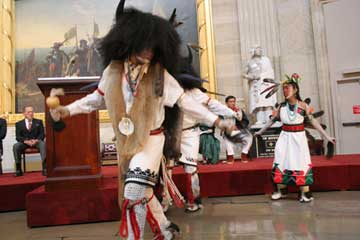 By JAMES W. BROSNAN Scripps Howard News Service September 22, 2005
The statue of Po'Pay also will stand for now in front of four large paintings that express conquering sentiments he surely would not have shared - Columbus stepping foot in the "New World," the Pilgrims embarking from Holland, DeSoto's "discovery" of the Mississippi River and the Baptism of Pocahontas. Po'Pay is a big departure from the 99 other historical figures represented in the Statuary Hall Collection, two from every state. His is the only statue that represents resistance to the invaders. Even the four other American Indians represented in the collection collaborated with the United States to some extent. Sakakawea (North Dakota) was the Shoshone girl who guided the Lewis and Clark expedition. Sequoyah (Oklahoma) created the Cherokee alphabet and was an envoy to Washington after President Andrew Jackson ordered the Cherokees removed from their lands in the Southeast to what became Oklahoma. Washakie (Wyoming), a Shoshone chief and father-in-law to mountain man Jim Bridger, negotiated with the United States for rights to the Wind River lands, where the Eastern Shosone still reside. Sarah Winnemucca (Nevada) was a Paiute who helped the U.S. Army during its war with the Bannocks. Po'Pay was a medicine man in the San Juan Pueblo who organized the 1680 revolt by sending runners to each of the pueblos with cords of agave fiber tied in knots. They were to untie one knot each day. When all were untied, the revolt commenced. Even though the Indians were armed only with clubs and arrows, they overwhelmed the Spanish advantage of guns and horses with sheer numbers. Po'Pay died before Spain re-conquered the pueblos in 1693. The Spanish were much more respectful of pueblo customs and religious practices after the revolt. Po'Pay helped ensure that the pueblo culture would survive, says Cliff Fragua, the Jemez Pueblo sculptor, who took two years to craft the statue from Tennessee marble. The statue's placement in the Capitol, said Fragua, "is going to educate people in the U.S. and the world about the pueblo culture and what it has meant to the history of the U.S." There are no known drawings of Po'Pay. Fragua said he let the stone make the image. The New Mexico legislature selected Po'Pay as its second representative in the Capitol Rotunda in 1997. The state's other statue is of the late Sen. Dennis Chavez, a champion of Hispanic and American Indian rights. Thursday's dedication ceremonies emphasized the aftermath of the Pueblo revolt, not the bloody details. 'For all of us in New Mexico the Pueblo Revolt taught us a lesson of tolerance," said Sen. Pete Domenici, R-N. M. A five-person American Indian dance group performed at the side of the U. S. Army Band. San Juan Pueblo Gov. Joseph Garcia prayed in his native tongue, which only survived because of Po'Pay, he said. The Joint Committee on the Library will decide Po'Pay's permanent home in the Capitol after his six-month showing in the Rotunda. Only 38 of the 100 statues in the Statuary Hall Collection are actually in Statuary Hall, the large second-floor chamber between the Rotunda and the House of Representatives. The rest line first- and second-floor corridors. Po'Pay is apt to have a lawyer or a politician as a neighbor - or both. One-third of those represented in the collection practiced law; two-fifths served in Congress. Many would recognize the names of historical giants like Henry Clay, Sam Houston, Ethan Allen, Daniel Webster, Samuel Adams, William Jennings Bryan, Robert E. Lee and Alexander Hamilton. But Julius Sterling Morton of Nebraska, the founder of Arbor Day? Or Dr. Ephraim McDowell of Kentucky, who took out President James Polk's gallstone? Some picks reflect the sentiments of the times. Illinois chose temperance leader Frances Willard in 1905, two decades before Chicago flowed with illegal booze and Eliot Ness battled Al Capone. Willard is one of only eight women. No state legislature has ever chosen a black American for the Statuary Hall Collection, but Congress tried to rectify that by placing a bust of the Rev. Martin Luther King in the Rotunda. ` Five statues honor inventors, but only Robert Fulton, inventor of the first American steamboat, might be familiar to most Americans. Florida honored John Gorrie, the inventor of refrigeration. Philo Farnsworth (Utah) was known as the "father of television." There is a king, Kamehameha I, a native Hawaiian; one entertainer, Oklahoman Will Rogers; and one astronaut, Jack Swigert, a Coloradan who flew on Apollo 13, got elected to Congress and died of cancer before he could take the oath of office. The lone artist is Charles Marion Russell (Missouri), painter and sculptor of cowboys and Indians. Great athletes make the Hall of Fame, but none has made it to Statuary Hall. Po'Pay's current closest neighbor, President Dwight Eisenhower, was the most recent addition to the collection, and the first use of a state's "do-over" powers. Congress said in 2002 that states could replace their first choices. The next year Kansas promptly voted in Ike and sent packing to Topeka its 19th-century governor and railroad attorney, George Washington Glick. Publish A Letter on SitNews Read Letters/Opinions Submit A Letter to the Editor
|
||
